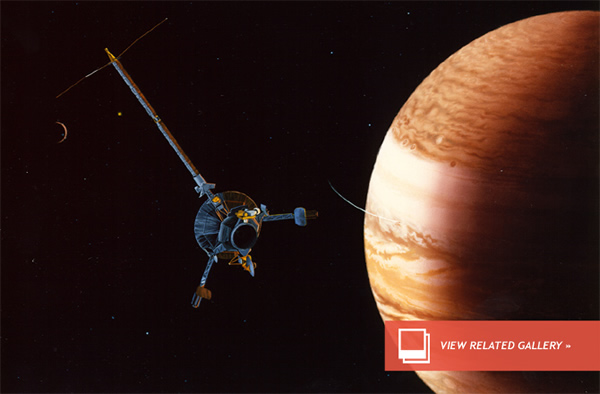Remembering Galileo's Jovian Triumphs
Remembering Galileo's Jovian Triumphs
It’s been a decade since NASA’s Galileo spacecraft plunged into Jupiter’s crushing atmosphere on Sept. 21, 2003, ending the mission that uncovered a wealth of information about our solar system’s largest planet and a handful of its moons. But the mission’s legacy lives on, because its discoveries not only changed how we view Jupiter, it changed the way we look at moons and asteroids, too.
Galileo was launched on Oct. 18, 1989, when the Jupiter-bound spacecraft was carried into orbit inside the space shuttle Atlantis’ cargo bay. It was released that same day, propelled by a two-stage solid motor booster on its interplanetary path. But it didn’t go straight to Jupiter. Galileo was the first mission to use a Venus-Earth-Earth gravity assist (VEEGA) trajectory to get to Jupiter using as little fuel as possible. The spacecraft flew past Venus on Feb. 10, 1990, and then passed the Earth twice – once on Dec. 8, 1990, and again on Dec. 8, 1992.
Finally en route to its target, Galileo didn’t coast silently. It made the first close flybys of some small asteroids — including the asteroid Ida, which it passed on Aug. 28, 1993, and found that it has a moon, Dactyl. Also during its interplanetary cruise, Galileo became the first spacecraft to witness the collision of two objects in space with a front row seat to comet Shoemaker-Levy 9’s plunge into Jupiter.
Galileo finally arrived at Jupiter on Dec. 7, 1995. It entered orbit and promptly dropped a probe into the atmosphere, the first one in history. This Galileo probe measured the temperature, pressure, windspeed, density of Jupiter’s atmosphere and gathered information on its chemical composition. All this information revealed the intensity of Jupiter’s stormy weather, storms that are significantly larger than anything we see on Earth. Galileo found these storms are caused by the vertical circulation of water in the top layers of the atmosphere, which leaves behind large areas void of moisture that become as dry as a desert.
After jettisoning it’s probe, the main spacecraft settled into orbit, surveying both Jupiter and a selection of its many moons.
Galileo shed some light on the mystery of Io’s volcanoes, which were first discovered by Voyager 1 in 1979 in a chance photograph. Scientists knew from studying the Voyager images that the volcanoes were the result of 328 foot tides expanding and contracting the moon’s surface. Information from Galileo’s temperature measurements revealed that some of Io’s volcanoes are hotter than any on Earth. With this information, scientists thing the lava that erupts on Io is made of silicate rich in magnesium.
This was also the mission that found evidence of a subsurface salty ocean on Europa that holds more water than the total amount of water on Earth. Images from the mission show rafts of ice the size of cities that seems to have broken off and drifted apart as well as smooth sections where water seems to have bubbled up to fill in old cracks in the surface ice.
But Europa wasn’t the only moon to give up its secrets to Galileo. The spacecraft also found that internal tidal friction has left Ganymede with a molten core, and this has given the moon its own magnetic field. Callisto, too, was revealed as an interesting and potentially wet moon. Galileo found evidence to support the existence of a subsurface ocean, deep enough that it doesn’t bubble up to smooth other the moon’s heavily cratered surface.
Galileo’s crash into Jupiter was a planned end to the mission. Had engineers not rerouted the spacecraft it would have smashed into Europa, possibly uncovering liquid evidence of the subsurface ocean. But of course, it would have been in no shape to send back data about touching water on another body.
Image credit: NASA(Sep 20, 2013 03:35 PM ET // by Amy Shira Teitel)












